3 min read
What is Predictive Index Hire?
What is PI Hire? Welcome to Tools of Talent Optimization, where we break down the key Predictive Index modules and show how they solve real people...
3 min read
Damon Clark : Aug 26, 2025 3:55:48 PM
-1.jpeg)
One of the biggest mistakes companies make is failing to align around the true requirements of a role.
In the alignment sessions we run with clients, misalignment almost always shows up. Why? Because many organizations still approach hiring the way it’s always been done: loosely defined roles, vague job descriptions, and overconfidence in “gut instinct.”
The problem is that hiring isn’t magic—and instinct is not a strategy.
Misalignment often shows up in a few critical ways:
Performance objectives aren’t defined. You need clear goals before you even start talking about skills.
Job requirements and qualifications are vague. If you don’t know what’s needed to hit performance objectives, you’re hiring blind.
Behavioral and cognitive expectations aren’t set. The right mindset and problem-solving ability are just as important as skills.
Hiring managers improvise their own process. Research shows structured, standardized interviews predict success far better than ad hoc conversations.
Without alignment, everyone in the hiring chain—executives, HR, recruiters, and hiring managers—ends up with different pictures of the ideal candidate. That confusion almost guarantees bad hires.
Too often, companies focus on filling a seat fast rather than filling it right. Hiring becomes a reaction to urgency rather than a deliberate process of attracting top talent.
Here’s where organizations trip up:
Weak pipelines. They don’t build active or passive candidate pipelines, which limits access to top performers.
Over-reliance on résumés. Past jobs, schools, or employer names don’t tell you who’s going to perform in the top 50%.
Internal promotions as the default. While promotions can be great, sometimes they’re used as a shortcut rather than truly assessing fit.
“Post and pray.” Putting a job online and hoping the perfect candidate applies is not a strategy—it’s wishful thinking.
Everyone wants A-players, but without a clear attraction and assessment strategy, you’ll end up with bottom-half performers filling critical seats.
Even if you manage to bring someone on board, the hiring process doesn’t stop at “Day One.” Retention is just as important as attraction—and poor engagement will undo your best recruiting efforts.
Consider this:
Bad hires don’t just fail in the role; they drag down morale, team performance, and ultimately revenue.
Losing a new hire within 9–12 months makes the entire hiring process a wasted investment.
Glassdoor reviews and word of mouth from disengaged employees discourage future top talent from applying.
Research shows only 55% of companies have a strategy to address engagement issues. That leaves nearly half of organizations in reactive mode.
The cost of a mis-hire is staggering: anywhere from the employee’s first-year salary to five times that amount for executives.
In other words: weak retention strategies erase all the effort you put into finding and onboarding talent.
Hiring shouldn’t be left to chance, instincts, or rushed decisions. Organizations that succeed at hiring build strong alignment, proactive attraction strategies, and deliberate engagement and retention plans.
Anything less, and the cost of mis-hires will keep catching up with you.
|
|
-1.jpeg)
3 min read
What is PI Hire? Welcome to Tools of Talent Optimization, where we break down the key Predictive Index modules and show how they solve real people...

2 min read
Are you wondering whether you’re really hiring the best people—and how to be more proactive and strategic in your hiring process? You’re not alone....
.jpeg)
1 min read
We hear this question a lot: “If we’re already struggling to find candidates, why would we add a behavioral and cognitive assessment into our...